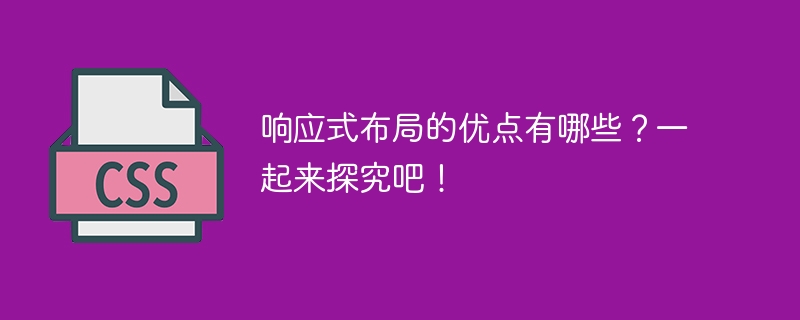

What are the advantages of responsive layout? Let’s explore together!
With the popularity and use of mobile devices, responsive layout has become an important trend in web design. Its purpose is to ensure that web pages can adapt to the screen sizes of different devices and provide a good user experience. Below we’ll explore the benefits of responsive layout and give some concrete code examples.
First of all, responsive layout can provide a consistent user experience. Whether the user is browsing the web on a mobile phone or a computer, responsive layout automatically adjusts the size of the layout and content to maintain a consistent look and functionality across different devices. This way users can easily access and use web pages no matter what device they use.
Secondly, responsive layout can provide better accessibility. By properly setting elements such as font size, spacing, and button size, responsive layout can make it easier for users to read and operate web content on different devices. For example, you can use media queries to set the font size on mobile phones to be larger, so that users don’t have to work hard to enlarge the web page to see the text clearly.
In addition, responsive layout can improve the loading speed of web pages. When users visit a web page, responsive layout can select appropriate loading methods for images and resources based on the size of the device and network conditions, thereby reducing loading time and data traffic. For example, you can choose to load small-sized images through media queries to display image content faster on mobile phones.
In addition, another important advantage of responsive layout is that it is easy to maintain and update. In the past, in order to adapt to different devices, web designers needed to create multiple independent pages, and these pages needed to be modified separately when updating content, which was very cumbersome. With responsive layout, you only need to maintain one page. Whether you add, modify or delete content, it can be applied to all devices with just one modification.
So, how to implement responsive layout? Some specific code examples are given below.
First of all, we can use CSS media queries to set different styles according to the device width. For example, when the device width is less than 600px, set the text font size to 16px, and when the width is greater than 600px, set the text font size to 20px. The sample code is as follows:
@media screen and (max-width: 600px) {
body {
font-size: 16px;
}
}
@media screen and (min-width: 600px) {
body {
font-size: 20px;
}
}Secondly, we can use CSS Flexbox layout to achieve flexible web page layout. For example, we can set up a web page layout with two columns, arranged vertically on mobile phones and horizontally on computers. The sample code is as follows:
<div class="container">
<div class="left-column">
<!-- 左侧内容 -->
</div>
<div class="right-column">
<!-- 右侧内容 -->
</div>
</div>.container {
display: flex;
flex-direction: column; /* 在手机上垂直排列 */
}
@media screen and (min-width: 600px) {
.container {
flex-direction: row; /* 在电脑上水平排列 */
}
}Finally, we can use image responsive technology to automatically adjust the image size. For example, you can use max-width: 100%; height: auto; to make the image automatically adapt to the width of its parent container and maintain the original aspect ratio. The sample code is as follows:
img {
max-width: 100%;
height: auto;
}Through the above code examples, we can see that responsive layout can realize the adaptation of web pages on different devices by using media queries, Flexbox layout and image responsive technology, and Delivering a consistent user experience, improved accessibility, faster loading times, and ease of maintenance and updates.
To sum up, responsive layout is of great significance in modern web design. It ensures that web pages appear optimally on different devices and provide a good user experience. By flexibly using various responsive technologies, we can adapt various web page layouts to meet user needs and improve the quality of web pages. Let us join the ranks of responsive layout and present users with a better web experience!
The above is the detailed content of Let's explore the benefits of responsive layout. For more information, please follow other related articles on the PHP Chinese website!
 Commonly used permutation and combination formulas
Commonly used permutation and combination formulas
 Which platform is better for virtual currency trading?
Which platform is better for virtual currency trading?
 What is the mobile service password?
What is the mobile service password?
 How to slow down video on Douyin
How to slow down video on Douyin
 What should I do if eDonkey Search cannot connect to the server?
What should I do if eDonkey Search cannot connect to the server?
 Big data analysis tools
Big data analysis tools
 float usage in css
float usage in css
 Login token is invalid
Login token is invalid




